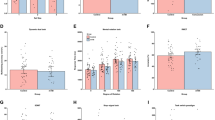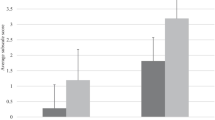Abstract
Several studies have focused on detection of simulated injury or submaximal effort using forced-choice measures of memory. However, few studies have examined the role of motor performance in patient effort, and no studies have examined motor functioning in an injury simulation. In this study, we administered measures of motor strength, motor speed, and attention and a forced-choice memory measure to 30 participants instructed to simulate brain injury and 30 participants instructed to perform to the best of their abilities. Simulators' level of performance and variability were significantly different from those of participants instructed to give maximal performance. Variables derived from motor measures may serve as useful supplemental indicators of incomplete effort.
Similar content being viewed by others
REFERENCES
Binder, L. M., and Willis, S. C. (1991). Assessment of motivation after financially compensable minor head trauma. Psychol. Assess. 3(2): 175–181.
Chengalur, S. N., Smith, G. A., Nelson, R. C., and Sadoff, A. M. (1990). Assessing sincerity of effort in maximal grip strength tests. Am. J. Phys. Med. Rehab. 69(3): 148–153.
Gilbert, J. C., and Knowlton, R. G. (1983). Simple method to determine sincerity of effort during a maximal isometric test of grip strength. Am. J. Phys. Med. 62(3): 135–144.
Greiffenstein, M. F., Baker, W. J., and Gola, T. (1996). Motor dysfunction in traumatic brain injury and postconcussion syndrome. J. Int. Neuropsychol. Soc. 2(6): 477–485.
Haaland, K. Y., Temkin, N., Randahl, N., and Dikmen, S. (1994). Recovery of simple motor skills after head injury. J. Clin. Exp. Neuropsychol. 16(3): 448–456.
Heaton, R. K., Grant, I., and Matthews, C. G. (1991). Comprehensive Norms for an Extended Halstead-Reitan Battery, Psychological Assessment Resources, Odessa, FL.
Iverson, G. L., and Franzen, M. D. (1996). Using multiple objective memory procedures to detect simulated malingering. J. Clin. Exp. Neuropsychol. 18(1): 38–51.
Iverson, G. L., Franzen, M. D., and McCracken, L. M. (1994). Application of a forced choice memory procedure designed to detect experimentally induced malingering. Arch. Clin. Neuropsychol. 9(5): 437–450.
Kreutzer, J. S., Gordon, W. A., Rosenthal, M., and Marwitz, J. (1993). Neuropsychological characteristics of patients with brain injury: Preliminary findings from a multicenter investigation. J. Head Trauma Rehab. 8(2): 47–59.
Matheson, L. N. (1988). How do you know he tried his best? The reliability crisis in industrial rehabilitation. Industr. Rehab. Q. 1(1): 1–3.
Millis, S. R., and Putnam, S. H. (1996). Detection of malingering in postconcussive syndrome. In Rizzo, M., and Tranel, D. (eds.), Head Injury and Postconcussive Syndrome, Churchill Livingstone, New York, pp. 481–498.
Mittenberg, W., Rotholc, A., Russell, E., and Heilbronner, R. (1996). Identification of malingered head injury on the Halstead-Reitan battery. Arch. Clin. Neuropsychol. 11(4): 271–281.
Niebuhr, B. R., and Marion, R. (1987). Detecting sincerity of effort when measuring grip strength. Am. J. Phys. Med. 66(1): 16–24.
Nies, K. J., and Sweet, J. J. (1994). Neuropsychological assessment and malingering: A critical review of past and present strategies. Arch. Clin. Neuropsychol. 9(6): 501–522.
Reitan, R. M., and Wolfson, D. (1993). The Halstead-Reitan Neuropsychological Test Battery: Theory and Clinical Interpretation, Neuropsychology Press, Tucson, AZ.
Robinson, M. E., Geisser, M. E., Hanson, C. S., and O'Connor, P. D. (1993). Detecting sub-maximal efforts in grip strength testing with the coefficient of variation. J. Occup. Rehab. 3(1): 45–50.
Smith, G. A., Nelson, R. C., Sadoff, S. J., and Sadoff, A. M. (1989). Assessing sincerity of effort in maximal grip strength tests. Am. J. Phys. Med. Rehab. 68(2): 73–80.
Trueblood, W., and Schmidt, M. (1993). Malingering and other validity considerations in the neuropsychological evaluation of mild head injury. J. Clin. Exp. Neuropsychol. 15(4): 578–590.
Wechsler, D. (1981). Wechsler Adult Intelligence Scale—Revised Manual, Psychological Corporation, New York.
Author information
Authors and Affiliations
Rights and permissions
About this article
Cite this article
Wall, J.R., Millis, S.R. Can Motor Measures Tell Us If Someone Is Trying? An Assessment of Sincerity of Effort in Simulated Malingering. International Journal of Rehabilitation and Health 4, 51–57 (1998). https://doi.org/10.1023/A:1022947719992
Issue Date:
DOI: https://doi.org/10.1023/A:1022947719992




